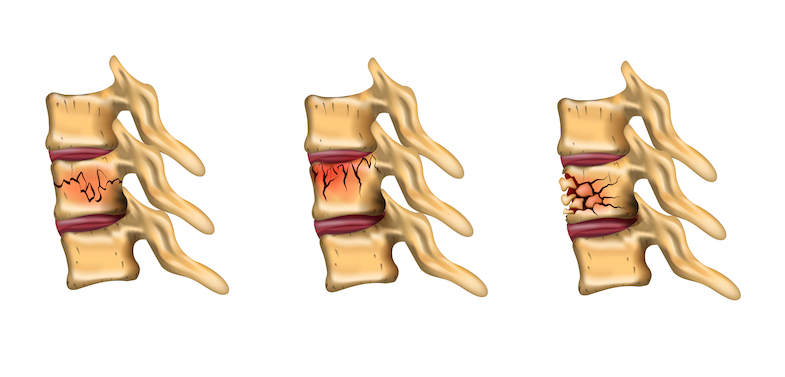When 80% of people in the U.S. suffer from a sore back at some point in their lives, it can be easy to dismiss that pain as just a minor nuisance. If you can still move around and it’s not that bad, it must not be serious, right? In some cases, aches and pains are the result of age or maybe a vigorous weekend of physical activity. In the case of compression fracture symptoms, though, they might start mild and get worse if left untreated. Here’s how to know the difference.
What is a compression fracture?
Our spinal column consists of 33 vertebrae in four sections:
- Cervical spine (neck)
- Thoracic spine (middle/upper back)
- Lumbar spine (lower back)
- Sacrum (base of the spine/tailbone)
The vertebrae in each of these sections are connected to the neighboring vertebra above and below, stabilized by connective tissue, and further supported by the muscles of the back. Movement is assisted by facet joints and eased by intervertebral discs.
This whole structure works beautifully—until it doesn’t. Vertebral compression fractures are small cracks or breaks in one or more vertebra. These fractures can occur anywhere along the spine but are most commonly found in the thoracic spine. This area of the spine includes the ribcage and is more rigid to protect sensitive vital organs. This same rigid protection means fractures are more likely.
Vertebral compression fracture causes
The bones of your spine are strong. The support systems within the spine that allow for both stability and movement contribute to that strength. But bones can weaken over time, especially when osteoporosis is present. Osteoporosis affects mostly women over the age of 55. Age thins and softens the bones. In severe osteoporosis, even a cough or sneeze can cause a vertebral compression fracture.
Vertebral compression fracture causes aren’t restricted to older adults, though. This type of injury can occur in full-contact sports, in car accidents, or with any other sudden trauma to an otherwise healthy back. And that can happen at any age and regardless of gender.
Another serious, but rare, cause of vertebral compression fracture is metastatic tumors. Cancer that spreads to the spine may cause breaks or cracks in the spine in patients under 55.
Types of compression fractures
There are three main types of compression fractures:
- Wedge: This is the most common type of fracture. The front of the vertebra cracks, but the back remains intact. This forms a wedge shape that can lead to permanent spinal deformity (i.e. kyphosis). A wedge fracture is mechanically stable, and the spine is still able to function.
- Crush: When the vertebrae crashes down evenly, this is referred to as a crush compression fracture. As with the wedge, a crush fracture can still function well, if painfully.
- Burst: Of the three types of compression fractures, a burst is the most serious and unstable. The vertebra shatters and sends pieces of bone in all directions, even towards the spinal cord. This is considered an emergency situation that requires immediate medical attention.
It’s important to note that stable compression fractures may not cause additional damage. Unstable fractures require treatment to prevent more serious vertebral compression fracture symptoms from occurring.

What does a compression fracture feel like?
Compression fractures range in effects from a minor to an excruciating pain.
Some people don’t have any vertebral compression fracture symptoms at all. They don’t even know they have one until another medical issue sends them to the doctor. For others, the pain is immediate and debilitating. Sharp, stabbing pain is characteristic of a vertebral compression fracture caused by sudden injury or trauma.
13 common vertebral compression fracture symptoms
As noted above, some people experience no vertebral compression fracture symptoms at all. This is most common when the fracture occurs in the early stages of osteoporosis.
Usually, pain will begin mildly after a minor event (e.g. lifting something heavy, bending and twisting at the same time, or jarring the spine). Symptoms from fractures due to osteoporosis may actually heal by themselves. Pain persists for about four to six weeks and can be managed with comfort measures.
Sometimes this pain becomes a dull ache right around the area of the fracture. Again, for many people, this pain will gradually subside over a period of weeks or months.
Others might find that their pain becomes chronic. This occurs for a couple reasons.
The injured person might have unconsciously changed how they walk or sit to relieve the pain in their back, or the healed bone may have changed the way it is sitting in the spine. Inactivity while the bone heals may also cause chronic pain as the body tightens up.
Regardless of the progression, here are 13 common vertebral compression fracture symptoms to look for. Note that not all who have vertebral compression fractures will experience the most severe symptoms, but it’s good to know what to look out for.
1. Sudden, sharp pain
A sudden sharp pain in the back is one of the first signs of a vertebral compression fracture. This may be a fleeting sensation after a jarring step. It might occur if you fall or sit down too suddenly. For some people, the pain is quick and brief. Others might experience a sharp pain that lingers.
2. Slight pain that gradually gets worse
Not all pain from compression fractures is sharp and sudden. Some people experience a mild onset that gradually worsens over time.
3. Pain that decreases when you lie down
Unlike sciatica (see below), you may experience pain relief when you lie down. This takes the pressure off the spine (and any compressed nerves).
4. Difficulty moving
A compromised spine may result in compromised movement. You may find yourself struggling to twist, bend, or stoop.
5. Pain in the back, arms, or legs
Some people report pain in the area of the fracture only. Others experience pain in the back, arms, or legs. Where pain is located depends on the fracture itself and other factors, including overall health or other underlying conditions.
6. Peripheral nerve pain
Peripheral nerve pain is pain that occurs in the extremities. People with diabetes are highly susceptible to peripheral nerve pain, but it can also occur in vertebral compression fractures.
7. Sciatica
Sciatica is the term for pain that occurs anywhere along the length of the sciatic nerve. If the vertebral compression fracture occurs in the lumbar spine, there is a possibility you will feel symptoms of sciatic pain. These include:
- Numbness in the legs and feet
- Buzzing or tingling sensation in the legs and feet (“pins and needles”)
- Burning or aching pain
- Pain that increases the longer you stay in one positions (sitting or standing)
- Tightness in the calf or hamstring
- Weakness in the legs
Sciatica is most commonly felt on one side of the body.
8. Spinal changes
In the later stages of thoracic compression fracture symptoms, you may notice changes to the spine. Instead of sloping slightly forward and up at the base of the neck, a thoracic compression fracture causes the spine to bulge outward. This may start as a mild bump and grow steadily worse without treatment.
9. Height loss
You may notice a loss of height over time, especially in the case of multiple fractures. Any one of the three types of vertebral compression fractures can cause a loss of height.
10. Tummy troubles
Another sign of multiple compression fractures is stomach issues. When your spine shortens, you may experience digestive issues such as constipation and low appetite.
11. Pain in the hips
Shortened spines bring the ribcage in close contact with the hips. If enough vertebrae are compromised, this might result in the ribcage actually touching the hip bones, rubbing and causing pain.
12. Difficulty breathing
Perhaps the most distressing of the vertebral compression fracture symptoms is also, thankfully, one of the least common. When multiple vertebrae are fractured, your lungs have less room for proper function. This may cause trouble breathing.
13. Loss of bowel or bladder control
This rare but serious compression fracture symptom requires immediate medical attention. Head straight to your nearest medical facility.
Are there compression fracture treatments that can help?
Compression fracture treatments for mild fractures are much different than treatments for compression fractures with the potential for serious damage.
The first and best treatment is prevention. Since many compression fractures can be traced to weak or thinned bones, preventing osteoporosis through diet and exercise is the best line of defense.
If you do experience minor pain associated with your compression fracture, non-steroidal anti-inflammatory drugs (NSAIDs) offer relief from pain and inflammation. A back brace can also help support your back as it heals.
With minor pain under control and a brace for support, physical therapy is your next option for compression fracture treatments. These strengthening exercises do not heal the fracture but provide support and strength to prevent further damage (and future fractures).
Some patients also find considerable relief using acupuncture for back pain. The treatment may be ancient, but modern support for it is growing.
If pain persists, or the threat of serious damage is possible, surgery may be an option. The two major types of vertebral compression fracture surgeries—vertebroplasty and kyphoplasty—are similar. Both surgeries increase the height between the collapsed vertebrae: vertebroplasty uses acrylic cement injected between the vertebrae; kyphoplasty uses a small balloon, inflated, to make space. Both of these procedures protect the structure of the spine while reducing back pain symptoms.
Another surgery, spinal disc decompression, may remove loose bone material or any disc material if the intervertebral disc has ruptured due to a fracture.
Except in emergency cases, surgery is generally only considered when other more conservative options have failed. Talk to your doctor about all of your options.
Get help
Back pain might be common, but it doesn’t have to be chronic. If you are suffering from compression fracture symptoms, it’s time to find help.
The pain specialists at Arizona Pain are committed to helping you get your life back. We offer comprehensive, personalized treatment plans for compression fracture symptoms. Get in touch to schedule your first appointment today!
